Mattress Toppers
Is There Really a Cooling Mattress Topper
Uncover the truth about cooling mattress toppers – find out how they can revolutionize your sleep quality and comfort.
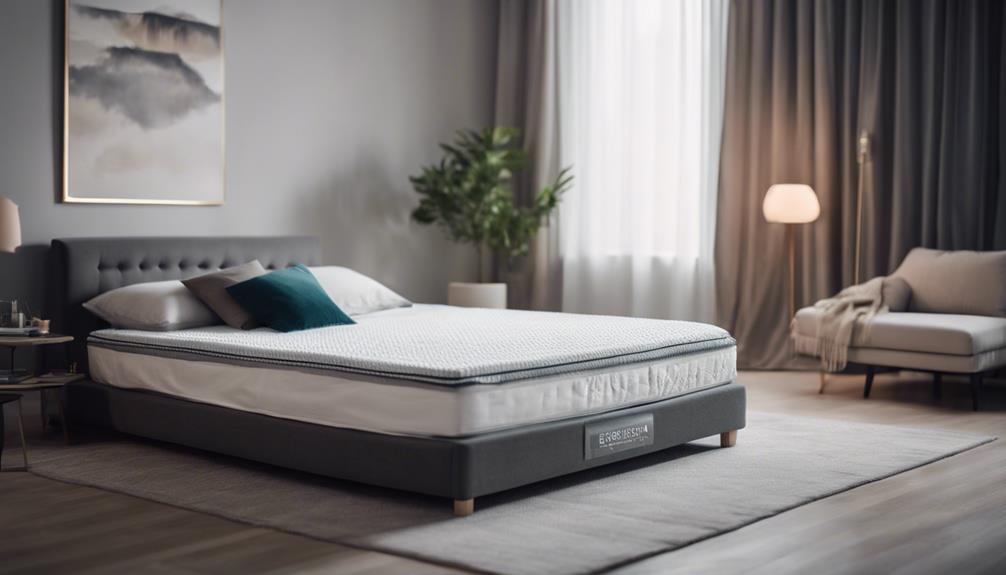
If you're wondering about the effectiveness of cooling mattress toppers, they do exist and offer relief from night sweats and overheating. Technologies like gel-infused memory foam and moisture-wicking materials regulate body temperature and enhance sleep quality. Factors like material selection and thickness influence comfort levels. Top options like Saatva's Cooling Graphite Topper and Tempur Adapt + Cooling Topper provide pressure relief and excellent airflow. For best results, opt for phase-change materials, guarantee ventilation holes, and follow care instructions. Exploring these options can lead to a more comfortable and restful sleep experience. Learn more about enhancing your sleep quality.
Key Takeaways
- Cooling mattress toppers exist with various technologies like gel-infused memory foam and moisture-wicking materials.
- They regulate body temperature, prevent overheating, reduce night sweats, and enhance sleep quality.
- Factors to consider include material selection, thickness options, and innovation for personalized comfort.
- Top options like Saatva's Cooling Graphite and Tempur Adapt offer pressure relief and excellent airflow.
- Tips for effective use include choosing phase-change materials, moisture-wicking fabrics, ventilation, and following care instructions.
Cooling Mattress Topper Technologies
Utilizing innovative materials and design features, cooling mattress toppers actively regulate body temperature for a more comfortable sleep experience. Gel-infused memory foam is a popular choice for cooling mattress toppers, as it effectively absorbs body heat and helps dissipate it throughout the night. Additionally, some toppers incorporate moisture-wicking materials like wool and poly-fiber to enhance their cooling properties. Ventilation holes are strategically placed in these toppers to improve airflow, contributing to better heat dissipation and overall comfort.
For those seeking advanced cooling technology, there are tech-powered cooling options available, such as water- or air-filled tubes within the topper that assist in temperature regulation. The primary goal of these cooling mattress toppers is to create a comfortable and pleasant sleep temperature by efficiently managing body heat absorption and dissipation. By improving airflow and utilizing innovative materials like gel-infused memory foam and moisture-wicking fabrics, these toppers provide a solution for individuals looking to enhance their sleep quality through temperature regulation.
Benefits of Cooling Mattress Toppers
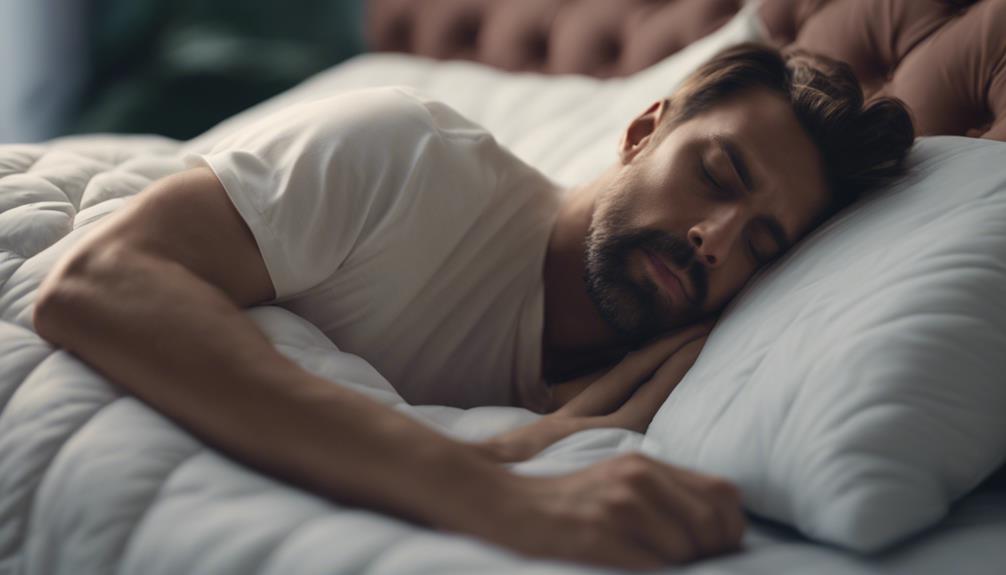
Cooling mattress toppers offer enhanced comfort and temperature regulation through advanced materials and design features. Here are some benefits of using cooling mattress toppers:
- Regulate Body Temperature: Gel-infused foam and other cooling materials in these toppers help regulate body temperature by dissipating heat and promoting airflow, ensuring a more comfortable sleep environment for hot sleepers.
- Prevent Overheating: The innovative technology in cooling mattress toppers works to prevent overheating during the night, allowing individuals to enjoy a more restful and uninterrupted sleep without feeling too hot.
- Reduce Night Sweats: By providing a cooler sleep surface and actively reducing heat retention, cooling mattress toppers can help minimize night sweats, improving overall sleep quality for those who tend to sweat excessively while sleeping.
Factors to Consider When Choosing
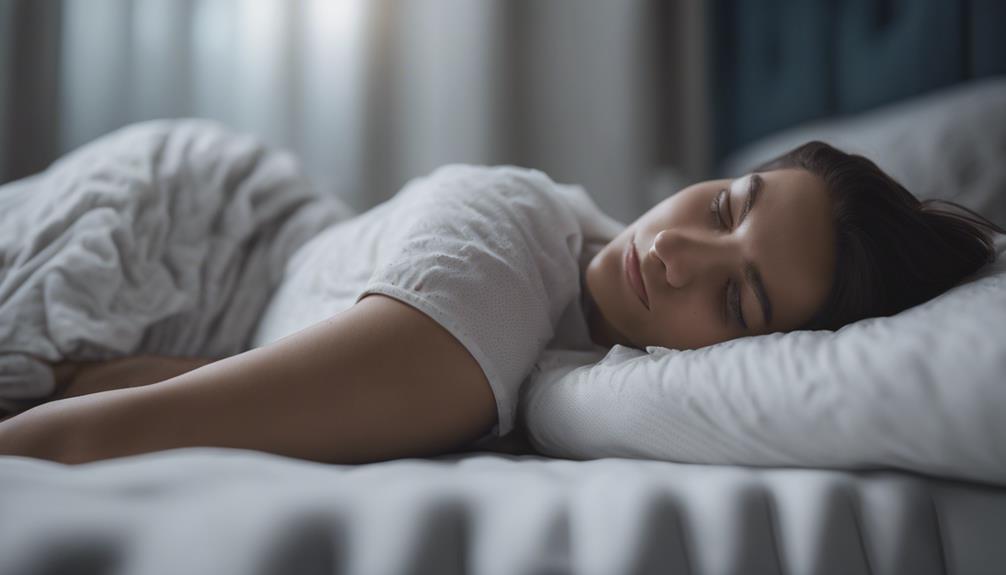
When selecting a cooling mattress topper, elements to take into account include the material selection and thickness options.
The type of material used in the topper will affect its cooling properties, with choices like gel, copper, or graphite offering different benefits.
Additionally, varying thickness levels can influence the overall comfort and support provided by the topper.
Material Selection
Considering various factors plays a significant role when selecting the material for a cooling mattress topper. When choosing the material, here are some key factors to keep in mind:
- Cooling Properties: Choose materials like gel-infused foam, copper-infused foam, phase-change materials, and breathable fabrics known for their effective cooling abilities.
- Moisture-Wicking Features: Look for materials such as wool or poly-fiber that offer moisture-wicking properties to help regulate body temperature and prevent overheating.
- Ventilation and Innovation: Consider features like ventilation holes for improved airflow, as well as mattress toppers with innovative cooling technologies like water- or air-filled tubes that actively regulate temperature for a cooler sleeping experience.
Matching the material with personal preferences is key to achieving the best cooling effect.
Thickness Options
When choosing a cooling mattress topper, thickness options ranging from 2 to 4 inches are important factors to take into account in order to achieve the desired comfort level and support. Thinner toppers, like the 2-inch ones, provide some cushioning but may not notably alter the feel of your mattress. On the other hand, thicker options, especially those at 3 inches and above, can greatly impact how your mattress feels, offering more cushioning and potentially changing the overall support it provides.
Consider your desired comfort level and how the thickness will affect the feel of your mattress before making a decision. The thickness of the topper can influence how much you sink into the mattress, so thicker options may offer a plusher feel.
Top Cooling Mattress Topper Options
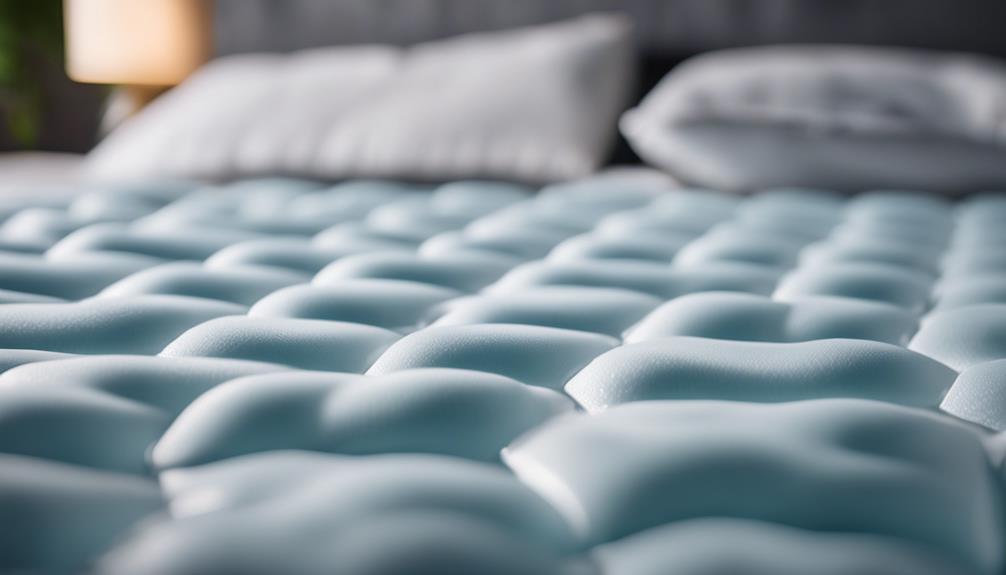
Among the top cooling mattress topper options are Saatva's cooling graphite topper, Tempur Adapt + Cooling Topper, and Nest Bedding cooling topper, all designed to regulate body temperature for a comfortable sleep experience. These toppers offer a medium-firm feel, pressure relief, and excellent airflow for a restful night's sleep.
- Saatva's Cooling Graphite Topper: This topper combines the cooling properties of graphite with the support of gel-infused memory foam, providing a comfortable sleeping surface that helps regulate body temperature.
- Tempur Adapt + Cooling Topper: Known for its pressure-relieving qualities, this topper incorporates materials like natural latex and cooling gel to offer a supportive yet cooling sleep environment.
- Nest Bedding Cooling Topper: Utilizing a blend of materials like gel-infused memory foam and down alternative options, this topper promotes airflow and support while ensuring a cool and comfortable rest throughout the night.
Tips for Using Cooling Toppers Effectively
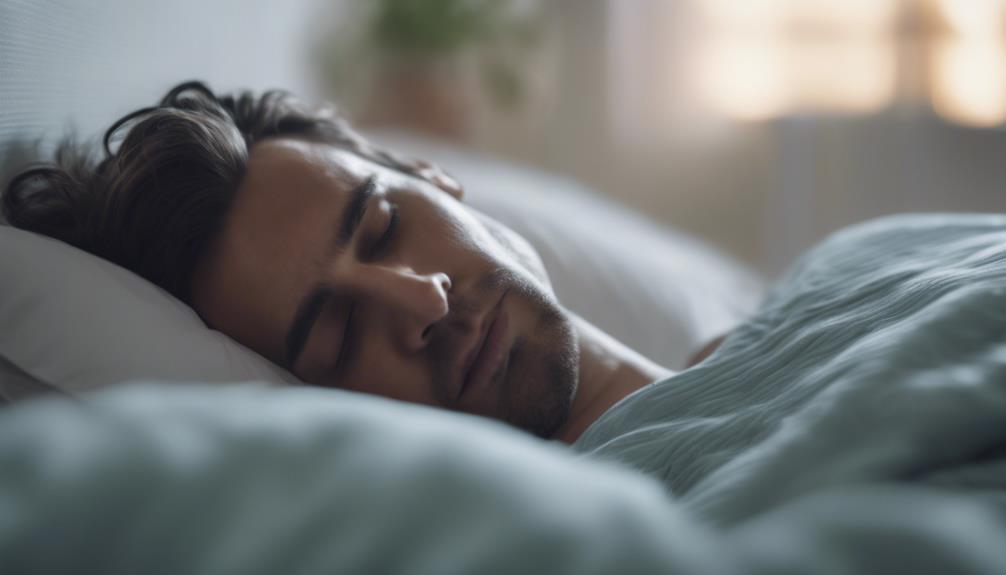
To make the most of your cooling mattress topper, it's important to implement effective tips that enhance its cooling capabilities and improve your sleep quality.
When choosing a cooling topper, opt for materials like phase-change materials or gel-infused foam to regulate body temperature efficiently. Look for moisture-wicking materials such as wool or poly-fiber to enhance cooling and sweat absorption. Make sure the topper has ventilation holes to promote airflow and prevent heat buildup during sleep.
For advanced cooling, consider tech-powered options with water- or air-filled tubes. Following the care instructions specific to your cooling topper is vital to maintain its cooling properties and prolong its lifespan.
Enhancing Sleep Quality With Cooling Toppers
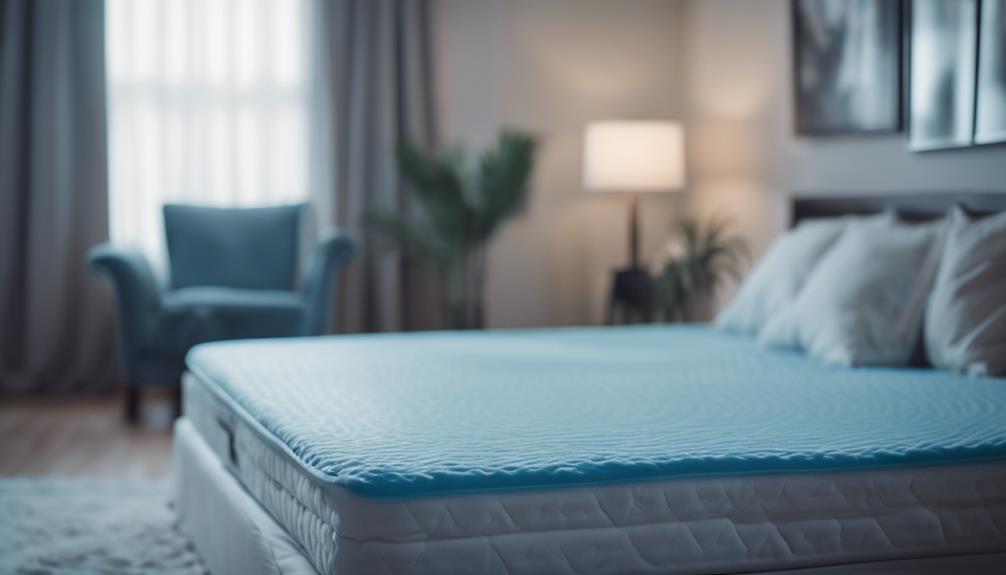
Cooling mattress toppers are designed to enhance sleep quality by regulating body temperature using materials like gel, copper, or graphite. Here are three ways these toppers help improve sleep:
- Moisture-Wicking Properties:
Many cooling mattress toppers incorporate moisture-wicking materials such as wool or poly-fiber. These materials draw moisture away from the body, keeping you dry and comfortable throughout the night.
- Ventilation Holes:
To promote airflow and aid in maintaining a comfortable sleeping temperature, some cooling toppers come with ventilation holes. These holes allow for better air circulation, preventing heat buildup and ensuring a restful night's sleep.
- Tech-Powered Cooling Mechanisms:
In addition to traditional materials, some cooling toppers utilize advanced cooling mechanisms like water- or air-filled tubes. These mechanisms provide extra cooling benefits, making them ideal for hot sleepers who struggle to stay cool while they rest.
Frequently Asked Questions
Do Cooling Mattress Toppers Really Cool?
Cooling mattress toppers use specialized materials to regulate body temperature and promote airflow for a cooler sleep surface. While they may not actively cool, they can help prevent overheating and enhance sleep quality.
The effectiveness of a cooling mattress topper depends on the materials used and individual needs for heat regulation. Research and reviews are valuable for selecting the best option based on preferences and desired cooling effects.
Is There a Mattress Topper That Doesn't Make You Hot?
Yes, there are mattress toppers that won't make you hot. Materials like gel-infused foam, phase-change fabrics, and ventilation holes help regulate temperature.
These toppers disperse heat, providing a cooler sleep surface. Users find them comfortable and cooler.
Opt for a cooling mattress topper to avoid overheating during sleep.
Can a Mattress Topper Help Keep You Cool?
Yes, a mattress topper can help keep you cool. Using materials like gel-infused foam or phase-change materials, cooling mattress toppers dissipate body heat and promote airflow, creating a cooler sleep surface.
These toppers prevent heat retention, making your sleeping environment more comfortable. Specifically designed for hot sleepers, they enhance overall sleep quality by maintaining a cooler temperature.
Investing in a cooling mattress topper can improve your sleep experience to a great extent.
Do Cooling Mattress Protectors Really Work?
Cooling mattress protectors are designed to regulate body temperature using materials like gel-infused memory foam or breathable fabrics. They effectively dissipate heat, providing a cooler sleeping surface for hot sleepers.
These protectors can reduce night sweats and discomfort caused by overheating, improving sleep quality. With hypoallergenic, waterproof, and easy-to-clean features, they offer more than just temperature regulation.
The effectiveness varies based on materials and preferences, but many users find them noticeably enhancing sleep comfort.
Can a Cooling Mattress Topper Actually Work to Keep Me Cool at Night?
A cooling mattress topper explained: Yes, it can work to keep you cool at night. These toppers are designed with breathable materials and gel-infused foam to regulate body temperature and wick away heat. They provide an extra layer of comfort and help prevent overheating, promoting better sleep quality.
Conclusion
To sum up, a cooling mattress topper can truly make a difference in your sleep quality. With innovative technologies and a range of benefits, these toppers offer a cool and comfortable night's rest.
By considering factors like material, thickness, and fit, you can find the perfect option for your needs.
So why not add a cooling mattress topper to your bed and experience a rejuvenating and invigorating sleep experience like never before?
Xavier – Your Operations Partner Xavier is your operations partner, working tirelessly behind the scenes to ensure that everything runs smoothly so you can enjoy a seamless experience with Perfect Fit Living. From managing inventory to coordinating logistics, he’s committed to making your experience with us hassle-free.
Mattress Toppers
Can You Stack Mattress Toppers
Answering the question of whether you can stack mattress toppers, discover why it's not recommended for optimal comfort and longevity.
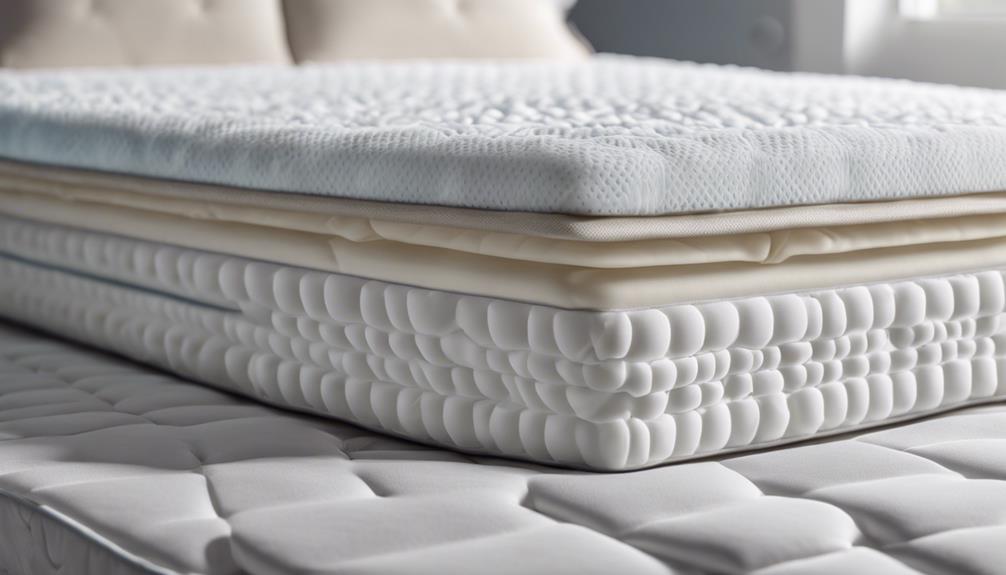
Yes, you can stack mattress toppers, but it's not recommended. Stacking may create an uneven surface, reduce support, and pose safety risks. It can also impact the toppers' durability, causing quicker wear and tear. Memory foam and latex toppers are particularly vulnerable to deformation. Opting for a single, thicker topper is advised to maintain support and comfort. Proper air circulation is vital to prevent moisture buildup and mold growth. Storing toppers in ideal conditions helps preserve their quality and longevity. Understanding the risks and best practices for topper use is essential for a restful sleep experience.
Key Takeaways
- Stacking toppers can create an uneven surface, reducing comfort and support.
- Safety risks increase with elevated mattress height, especially for children and elderly.
- Allergens and bacteria can accumulate between stacked toppers, impacting hygiene.
- Durability of toppers can decrease due to increased pressure and compression.
- Opt for a single, thicker topper to prevent material compression and deformation.
Risks of Stacking Mattress Toppers
We've found that stacking mattress toppers can pose various risks that impact both comfort and health. When you stack different types of toppers, such as a memory foam topper on top of a latex one, you might end up with an uneven sleeping surface. This could lead to reduced back support and spinal misalignment, affecting the quality of your sleep. Improper alignment can result in discomfort and health issues over time.
Additionally, stacking toppers can increase the height of your mattress, causing your sheets to fit poorly and potentially creating safety hazards, especially for children or elderly individuals.
Moreover, health risks like allergen accumulation and bacterial growth can arise from the moisture trapped between stacked toppers. These conditions may exacerbate allergies or respiratory problems, impacting your overall well-being. To improve your sleep and minimize these health risks, it's advisable to use a single high-quality mattress topper that meets your comfort and support needs without the need for stacking.
Impact on Toppers' Durability
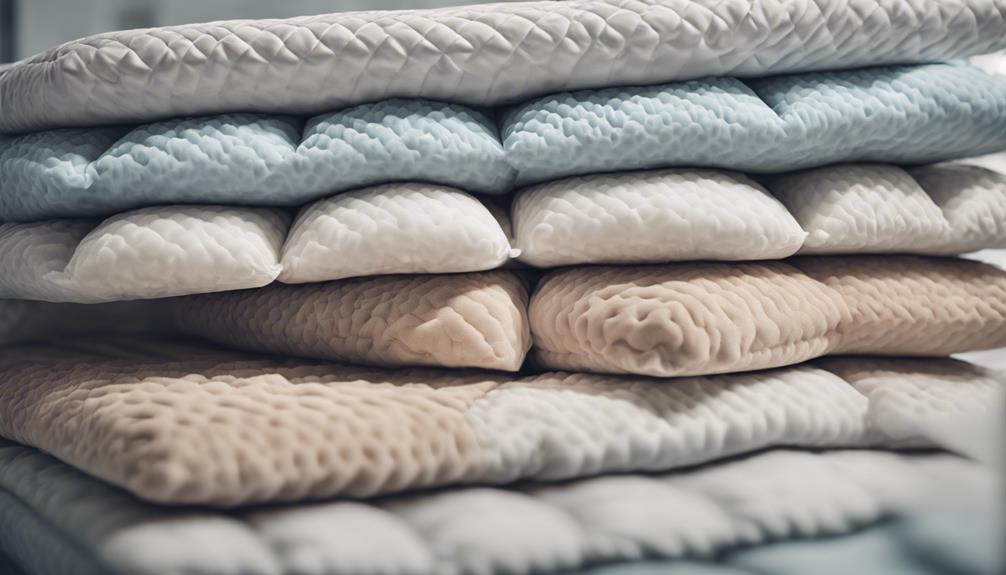
Layering mattress toppers can greatly reduce their durability by subjecting them to increased pressure and compression, leading to quicker wear and tear on the materials. When stacking multiple toppers, such as memory foam or latex toppers, the weight distribution and stress can cause them to lose their original shape and support over time.
Memory foam and latex toppers are particularly vulnerable to compression and deformation when stacked on top of each other. This can result in a decrease in their overall lifespan and comfort. To maintain the integrity and longevity of your mattress toppers, it's advisable to avoid stacking them.
Material Compression and Deformation

Material compression and deformation often occur when stacking mattress toppers, particularly with memory foam and latex varieties. Continuous pressure from stacking can cause these materials to lose their original shape, leading to a decrease in support and comfort over time. Memory foam and latex toppers are vulnerable to compression, which may impact the overall performance of the toppers.
To avoid material compression and deformation, it's recommended to opt for a single, thicker topper instead of stacking multiple layers. By choosing a thicker topper, you can reduce the likelihood of excessive pressure that contributes to material deformation. This approach helps maintain the integrity of the memory foam or latex material, ensuring that it retains its supportive and comfortable properties for a longer period.
When considering stacking mattress toppers, be mindful of the potential effects of material compression and deformation on the overall quality of your sleep surface. Opting for a single, high-quality topper can help mitigate these concerns, enhancing the longevity and performance of your bedding.
Air Circulation and Moisture Concerns

When stacking mattress toppers, it's important to consider how air circulation plays a key role in preventing moisture buildup and potential mold growth between the layers. Moisture trapped between stacked toppers can compromise the material integrity and hygiene of the bedding.
To avoid this, proper spacing and ventilation between toppers are essential. Inadequate air circulation in stacked toppers may contribute to odors and discomfort during sleep. Addressing air circulation concerns is essential to preserve the quality and performance of the mattress topper.
Without sufficient airflow, moisture buildup becomes more likely, leading to potential issues. Hence, when stacking mattress toppers, it's crucial to create pathways for air to flow between the layers, preventing any trapped moisture. This simple step can go a long way in maintaining the freshness and longevity of the stacked toppers, ensuring a comfortable and healthy sleeping environment.
Storage Recommendations for Toppers
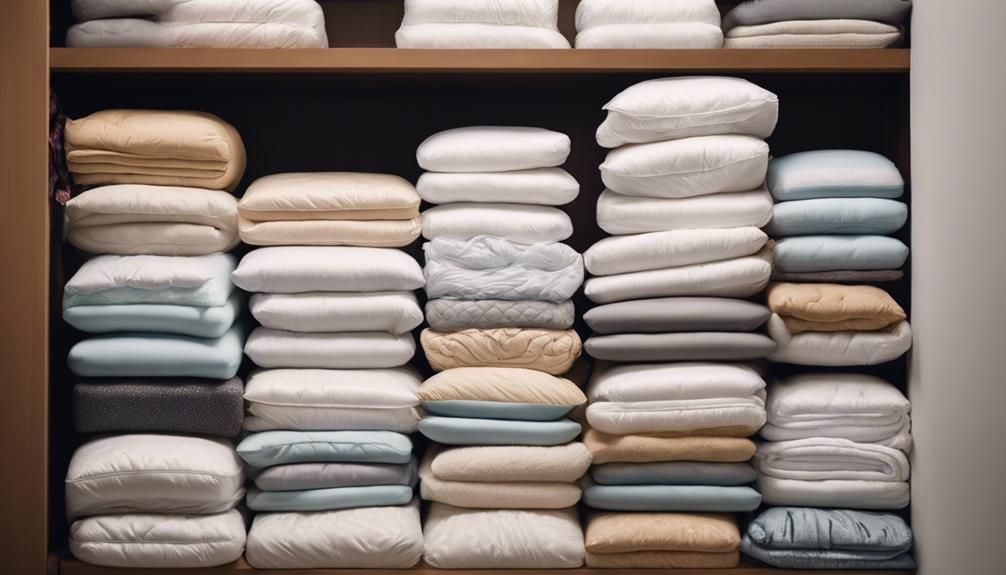
To maintain the quality and longevity of your mattress toppers, proper storage in controlled humidity and stable temperatures is crucial. When storing your mattress toppers, consider the following recommendations:
- Ideal Storage Locations: Choose areas such as closets, spare beds, or under the bed for storing your mattress toppers. If using attics or storage units, exercise caution to guarantee exposure to extreme temperatures or humidity fluctuations.
- Breathable Storage Bags: Opt for storage bags made of breathable materials to allow air circulation. These bags help prevent moisture buildup, maintain freshness, and safeguard against dust and allergens.
- Material Considerations: Select storage bags with secure closures, washable features, and UV protection to safeguard the longevity of your mattress toppers.
Best Practices for Maintaining Toppers
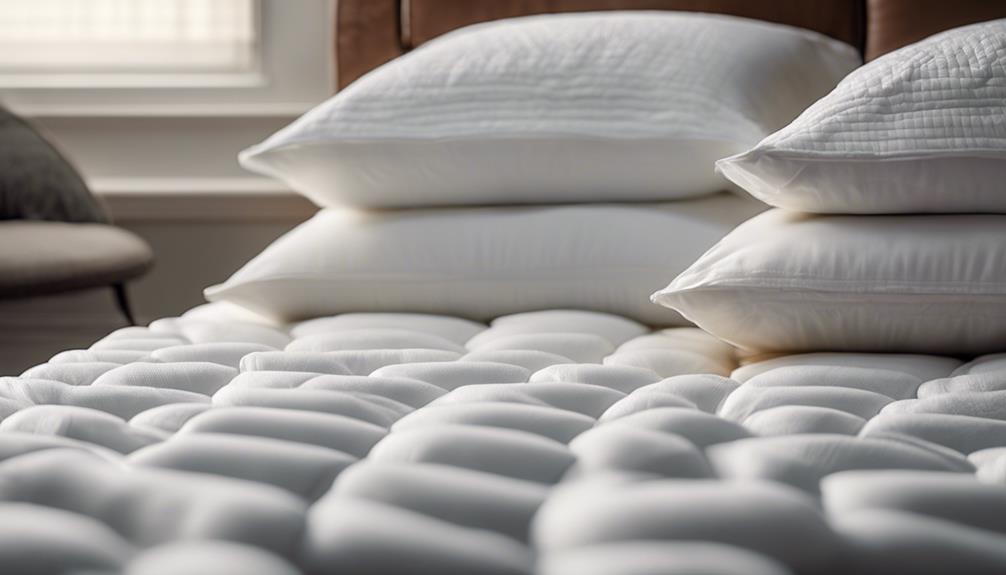
Maintaining mattress toppers is key to ensuring their longevity and performance.
Regularly rotating toppers promotes even wear, while using a mattress protector shields against spills and allergens.
Vacuuming periodically and following manufacturer's cleaning guidelines are essential steps in caring for toppers.
Cleaning Mattress Toppers
Regularly cleaning your mattress topper is crucial to maintaining its hygiene and prolonging its lifespan. Depending on the material of your topper, specific cleaning methods should be followed to guarantee its longevity and performance. Here are some basic cleaning tips for different types of mattress toppers:
- Memory Foam Toppers: Use mild detergent and water, then thoroughly rinse and air dry to maintain hygiene and prevent damage.
- Latex Toppers: Clean with mild soap and water, ensuring proper drying to prevent mold growth and preserve shape and quality.
- Feather or Down Toppers: Spot clean following care instructions, and ensure thorough drying to avoid odors and maintain freshness.
Regular cleaning not only keeps your mattress topper fresh but also helps in preventing odors and maintaining its quality.
Rotating for Even Wear
Implementing a regular rotation schedule for your mattress topper is essential for ensuring even wear and prolonging its lifespan. By rotating the topper regularly, you can prevent indentations and maintain uniform compression.
Switching the topper end to end and alternating its position every few months helps sustain consistent support and comfort. This practice also aids in distributing body weight evenly, reducing wear on specific areas.
Following a rotation schedule recommended by the mattress topper manufacturer is vital for preserving the topper's quality and performance. Remember, rotating your mattress topper is a simple yet effective way to extend its lifespan and make sure that you continue to enjoy a comfortable and supportive sleep surface for years to come.
Storage Tips for Toppers
Storing mattress toppers in suitable conditions is essential for preserving their quality and ensuring long-lasting comfort. When it comes to maintaining toppers, here are some best practices to keep in mind:
- Controlled Environment: Store in areas with stable temperatures and controlled humidity to prevent material damage.
- Proper Locations: Consider storing in closets, spare beds, or under beds to avoid dust and allergens.
- Breathable Storage Bags: Opt for breathable bags with secure closures and washable features to circulate air and prevent mold growth.
Following these proper storage practices can help prevent compression, deformation, and vulnerability of memory foam and latex toppers, ensuring their longevity and your comfort.
Frequently Asked Questions
How to Layer Mattress Toppers?
Layering mattress toppers is a great way to customize comfort and support. Start by selecting toppers with different materials and thickness for a personalized feel.
Guarantee proper sizing and compatibility to avoid fit issues when stacking toppers. Consider the overall height increase and impact on sheet fit when layering multiple toppers.
Experiment with various combinations to find the perfect balance of cushioning and support for a restful night's sleep.
Can You Put Two Memory Foam Mattresses on Top of Each Other?
Yes, stacking two memory foam mattresses isn't recommended. Doing so can result in uneven support, affecting comfort and overall performance.
Compression of the top mattress may lead to discomfort and reduced breathability, increasing heat retention. Memory foam mattresses are designed as standalone units for best sleep quality.
It's best to avoid stacking memory foam mattresses to guarantee a restful and supportive sleep experience.
Can You Put a Mattress Topper on Top of a Memory Foam Topper?
We can enhance comfort and support by placing a mattress topper on top of a memory foam topper. The additional topper adjusts firmness levels or provides extra cushioning as needed.
Compatibility depends on thickness, material, and personal preference. Consider the best possible height and feel of stacked toppers for top-notch sleep quality.
Experiment with different combinations to find the ideal comfort and support for our specific needs.
How to Store Mattress Toppers?
When storing mattress toppers, it's essential to keep them in a well-suited humidity environment to prevent moisture damage. Ideal storage places include closets, spare beds, under the bed, and cautiously in the attic.
To avoid mold, odors, dust, and allergens buildup, use breathable storage bags with secure closures. Remember to choose bags with washable features, UV protection, and the right size for effective topper storage.
Conclusion
To sum up, stacking mattress toppers may seem like a convenient way to customize comfort, but it can actually lead to premature wear and tear.
While some individuals may find temporary relief from adding extra layers, the long-term impact on the toppers' durability and performance is a significant concern.
To maintain the quality and lifespan of your mattress toppers, it's best to use them individually and follow proper storage and maintenance practices.
Xavier – Your Operations Partner Xavier is your operations partner, working tirelessly behind the scenes to ensure that everything runs smoothly so you can enjoy a seamless experience with Perfect Fit Living. From managing inventory to coordinating logistics, he’s committed to making your experience with us hassle-free.
Mattress Toppers
Where Does Mattress Topper Go
Curious about where your mattress topper should go for ultimate comfort and support?
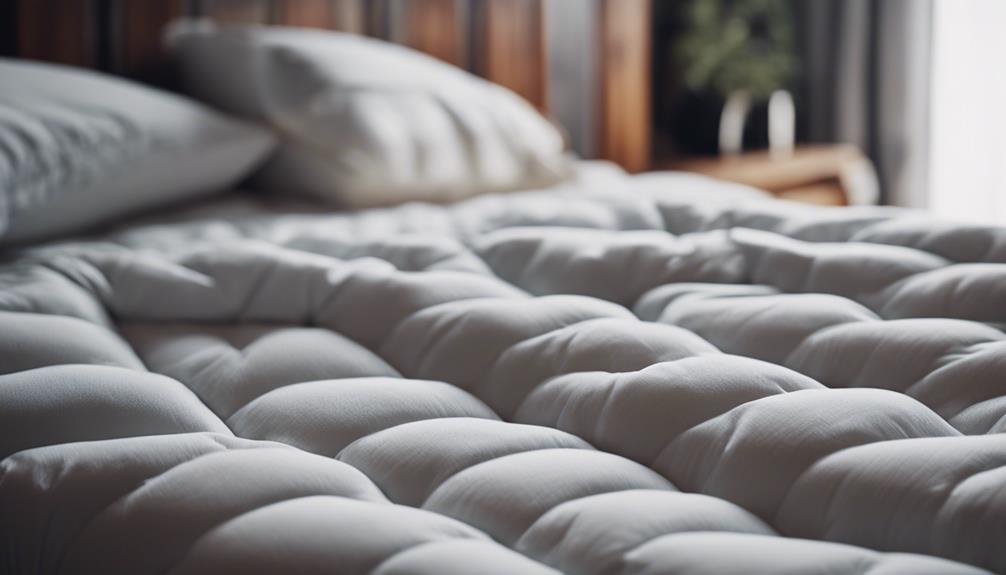
When setting up your mattress topper, place it directly on top of your mattress for best comfort and support. Make sure a snug fit to prevent shifting, and consider using a cover for protection against dust and dirt. Choose a material that balances durability and comfort, and follow cleaning routines for longevity. For an extra layer of softness, consider using a mattress pad in addition to the topper. Remember, how you position your topper can greatly impact your sleep quality and overall comfort. More insights on maximizing your mattress topper's benefits await.
Key Takeaways
- Place the mattress topper directly on top of the mattress for comfort and support.
- Secure the topper with a fitted sheet or protector to prevent shifting.
- Add a cover for protection against dust and dirt, extending its lifespan.
- Layer a mattress pad for extra softness and cushioning on top of the topper.
- Utilize a mattress protector over the topper to prolong both their lifespans.
Proper Placement of Mattress Topper
When placing a mattress topper for maximum comfort and support, position it directly on top of the mattress and secure it snugly before adding any other bedding layers. This guarantees that the topper stays in place throughout the night, providing a consistent level of comfort for a good night's sleep.
Additionally, using a cover can offer protection against dust and dirt, ultimately extending the lifespan of the mattress topper. When selecting a mattress topper, consider the material carefully to balance durability and comfort based on personal preferences. Different materials offer varying levels of support and softness, catering to individual needs for a restful sleep experience.
Proper cleaning and maintenance routines are essential for preserving the quality of the mattress topper over time. By following specific care instructions, such as regular cleaning and airing out, you can enhance the longevity of the topper and continue to enjoy its benefits for years to come.
Setting Up Mattress Topper Correctly
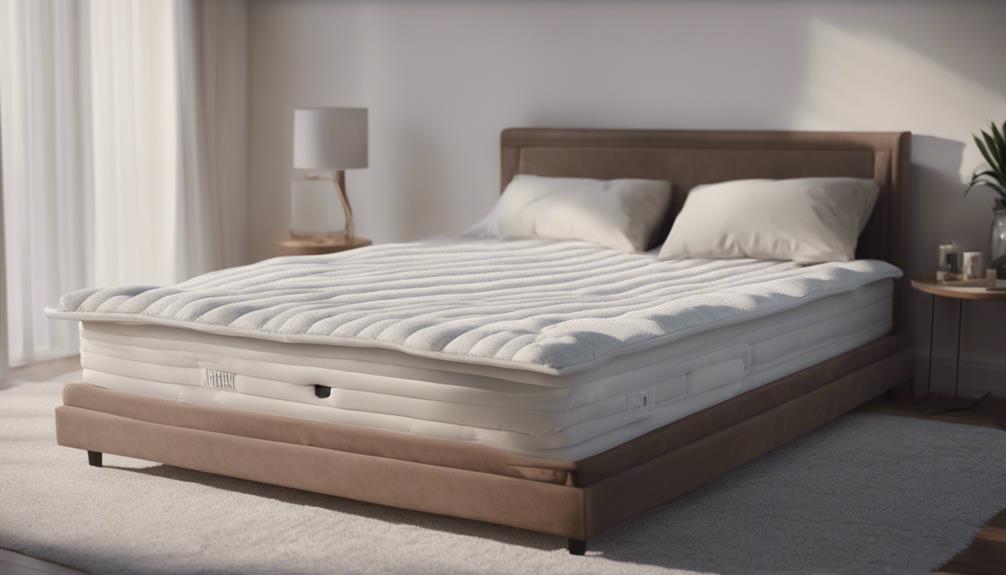
To optimize comfort and support, we recommend placing the mattress topper directly on top of the mattress. Ensuring a snug fit is vital, as it enhances the overall feel of the bed. Adding a mattress protector or cover over the topper not only protects it from dust and dirt but also increases its longevity. For a seamless look and added comfort, position the topper underneath the fitted sheet to make it an extension of the mattress itself. This setup not only keeps the topper securely in place but also provides a smooth surface for sleeping. Properly setting up the mattress topper in this manner can greatly enhance sleep quality and overall comfort, making your bed feel like a luxurious retreat.
| Step | Action | Importance |
|---|---|---|
| Place Topper | Directly on top of the mattress | Optimal comfort and support |
| Ensure Snug Fit | Securely on the mattress surface | Enhanced bed feel |
| Add Cover | Protects from dust and dirt, increases longevity | Maintenance and cleanliness |
| Position Under Sheet | Functions as an extension of the mattress | Seamless look and added comfort |
Bedding Arrangement With Mattress Topper
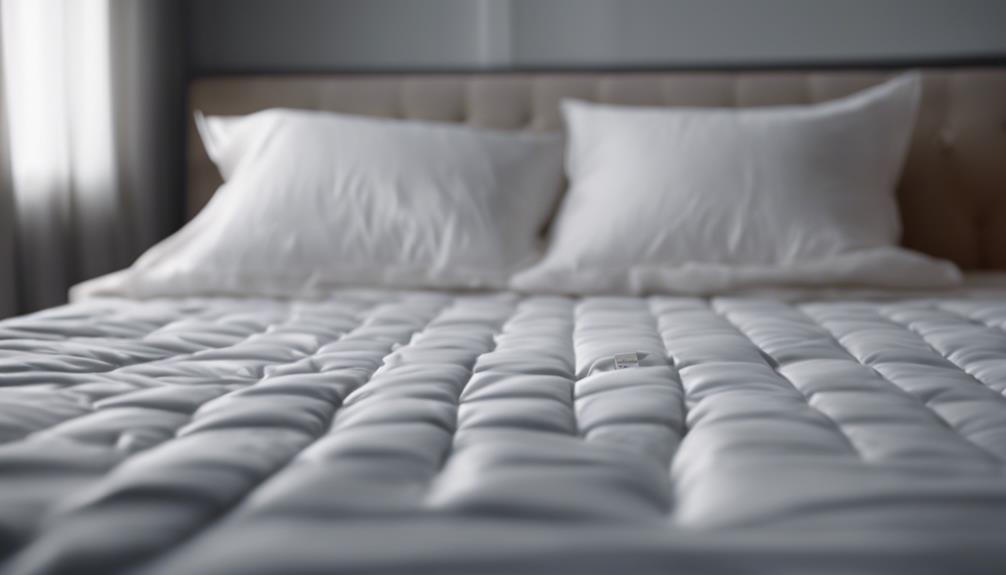
When arranging bedding with a mattress topper, it's crucial to place the topper directly on the mattress for best comfort. To secure it in place, utilize a fitted sheet or protector over the topper.
Additionally, consider adding a cover to protect the topper from dust and dirt, extending its lifespan.
Placement on Mattress
Placing the mattress topper directly atop the mattress enhances comfort and support for a better night's sleep. To guarantee it stays in place, secure the topper with a fitted sheet or mattress protector.
Adding a cover over the topper not only protects it from dust and dirt but also extends its lifespan. For extra softness and cushioning, layer a mattress pad on top of the topper.
Additionally, consider using a mattress protector over the topper to shield both the topper and mattress from spills and allergens. This layered approach not only enhances the comfort of your bed but also helps maintain a clean and hygienic sleeping environment.
Layering With Sheets
After securing the mattress topper with a fitted sheet or mattress protector, consider utilizing bed sheet fasteners for added stability when layering bedding with the topper.
The mattress topper adds extra comfort and support, so it's important to have a secure fitted sheet on top. Bed sheet fasteners, also known as bed sheet suspenders, can help prevent the sheets from slipping, especially with thicker toppers. These fasteners can even convert flat sheets into fitted sheets, providing convenience and ensuring a snug fit.
When deciding on whether to include flat sheets in your bedding arrangement with the mattress topper, it ultimately comes down to personal preference and regional practices. Experiment with different layering options to find what works best for your comfort and sleeping habits.
Benefits of Topper
Using a mattress topper in your bedding arrangement can greatly enhance your sleep experience by adding an extra layer of luxury and comfort.
- Memory foam toppers provide extra comfort and support.
- They help protect the mattress, extending its lifespan.
- Adding a topper can save you money by revitalizing old mattresses.
- Toppers are versatile, offering comfort in various settings.
Mattress Topper Positioning Guide
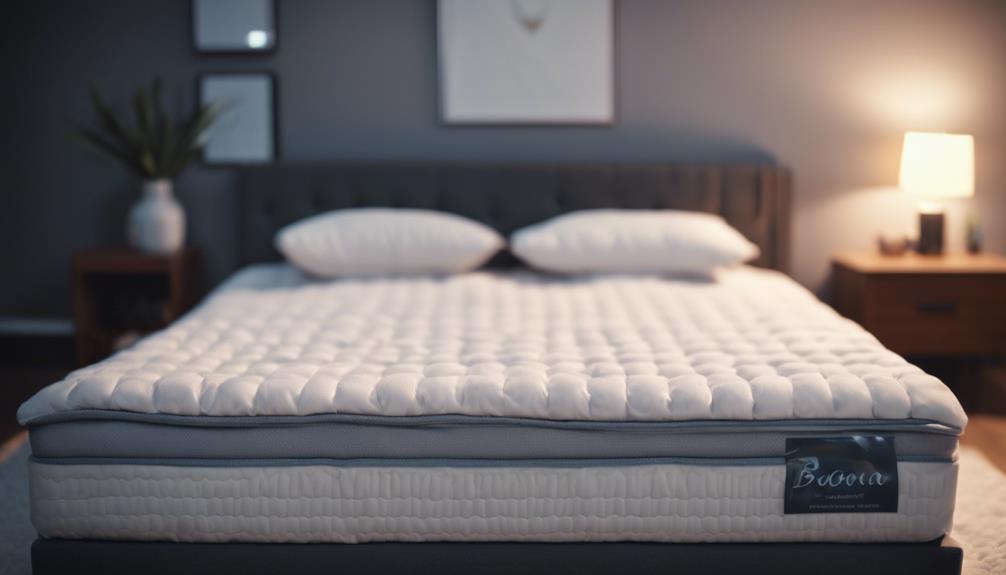
To optimize comfort and support, position the mattress topper directly on top of the mattress. Whether it's a memory foam, gel memory foam, or another type of topper, placing it on the mattress enhances the sleeping experience.
For a secure fit, use a fitted sheet or mattress protector over the mattress topper. This not only keeps the topper in place but also adds an extra layer of protection. Consider adding a cover to shield the mattress topper from dust and dirt, increasing its durability.
To further enhance the softness and cushioning, you can top the mattress topper with a mattress pad. Correct positioning of these mattress accessories can improve overall sleep quality and prolong the lifespan of your mattress.
Where to Put Your Mattress Topper
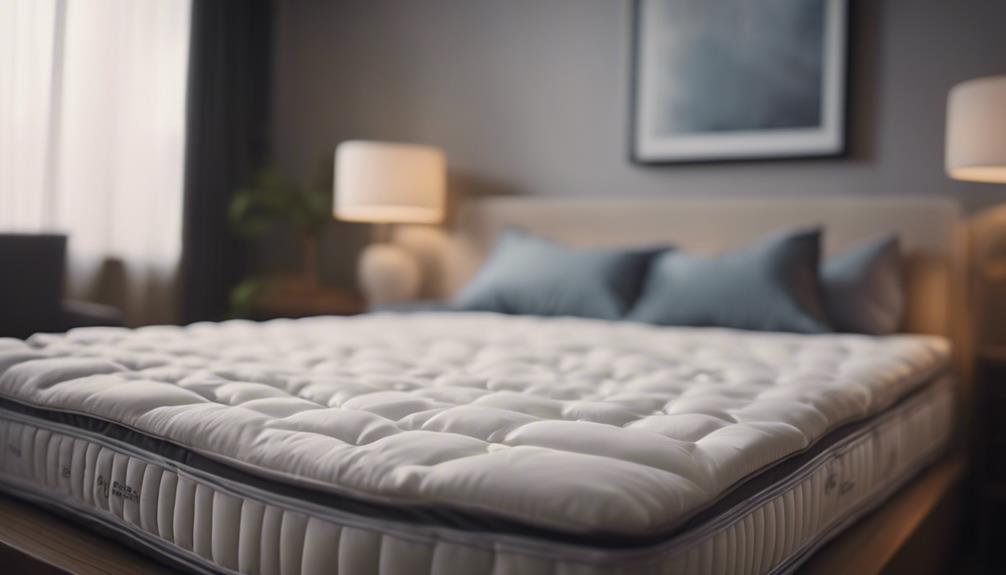
When determining where to place your mattress topper, it's crucial to position it directly on top of your mattress to enhance comfort and support.
Remember to secure the topper beneath a fitted sheet or mattress protector for stability.
Additionally, consider using a cover to shield the topper from dust and dirt, extending its longevity.
Bed Placement Tips
Placing the mattress topper directly atop the mattress not only enhances comfort but also promotes better support for a restful night's sleep. Here are some bed placement tips for your mattress topper:
- Position the topper between the mattress and the fitted sheet for a secure fit.
- Proper alignment can help alleviate pressure points and improve sleep quality.
- The topper acts as an additional layer of cushioning, adding comfort.
- Placing the mattress topper directly on the mattress can help extend the lifespan of both the topper and the mattress.
Mattress Topper Care
We always recommend placing the mattress topper directly on top of the mattress for enhanced comfort and support. It's crucial to make sure the mattress topper is secured in place before adding any additional layers.
Adding a cover to the mattress topper can protect it from dust and dirt, extending its lifespan. Remember, the mattress protector should go over the mattress topper to shield it from spills, stains, and allergens.
Properly positioning the mattress topper is essential for maximizing its benefits and maintaining mattress hygiene. By following these care tips, you can enjoy a clean, comfortable sleep surface that provides the support you need for a restful night's sleep.
Topper Storage Ideas
Storing your mattress topper properly is essential to maintain its quality and prolong its lifespan. To guarantee your mattress topper stays in top condition, consider the following storage ideas:
- Store your mattress topper in a cool, dry place to prevent moisture buildup and mold growth.
- Consider using a vacuum storage bag to compress and protect your mattress topper when not in use.
- Utilize under-bed storage containers to keep your mattress topper clean and easily accessible.
- Hang your mattress topper on a sturdy hanger in a closet to preserve its shape and prevent creases.
Remember to avoid direct sunlight and extreme temperatures when storing your mattress topper to keep it in excellent condition.
Using a Mattress Topper Effectively
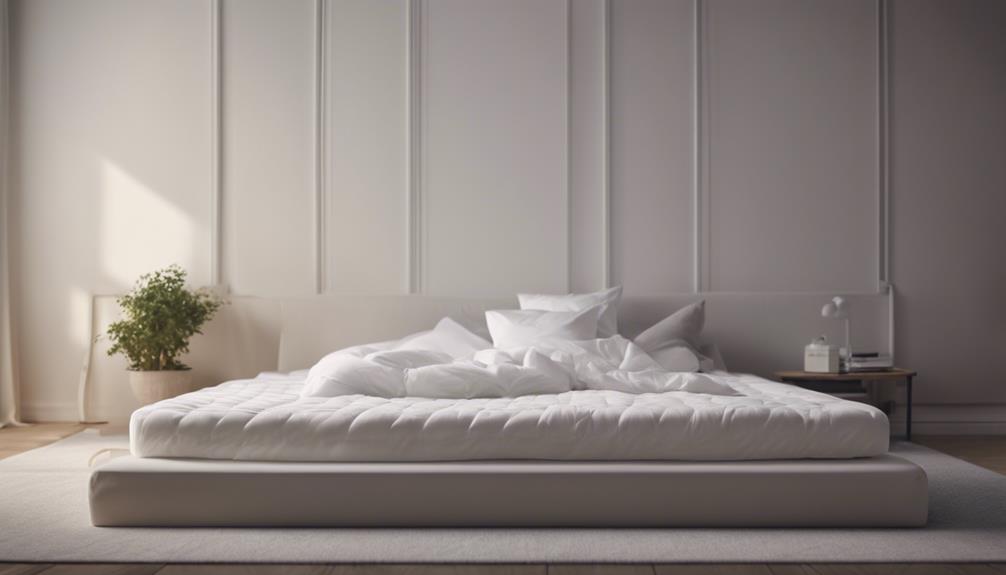
For maximum comfort and support, position the mattress topper directly on top of the mattress. This guarantees that you benefit from the added layer of cushioning and pressure relief that the mattress topper provides.
To maintain stability and hygiene, use a fitted sheet over the mattress topper to secure it in place and protect it from dust and dirt.
Additionally, consider layering a mattress pad on top of the topper for extra softness and comfort, similar to how a comforter enhances a bed.
To prolong the lifespan of both your mattress and topper, utilize a mattress protector over the topper. This protector acts as a barrier against spills, dust, and allergens, enhancing the overall longevity of your bedding.
Frequently Asked Questions
Where Should a Mattress Topper Be Placed?
When considering where to place a mattress topper, it's crucial to prioritize comfort and support. By laying the topper directly on the mattress, you create an extra layer that enhances your sleep quality. This placement not only adds cushioning and protection but also helps extend the life of your mattress.
To guarantee a secure fit, make sure to position the topper before adding other bedding layers. A well-placed mattress topper can greatly improve your overall sleeping experience.
Does Mattress Topper Go Directly on Mattress?
Yes, a mattress topper goes directly on the mattress. Placing it on top enhances comfort and support. This setup adjusts the firmness effectively.
Ensuring you experience all the benefits, it creates a seamless and cozy sleep surface. So, yes, the topper should definitely go directly on the mattress for the best rest possible.
Does a Mattress Topper Go Over or Under the Sheet?
We usually place the mattress topper over the mattress and under the fitted sheet for extra comfort. This arrangement helps guarantee the topper stays in place while we sleep.
The fitted sheet acts as a layer that secures the topper, preventing it from shifting or sliding. By having the topper under the fitted sheet, we secure a smooth and even sleeping surface.
Plus, this setup enhances hygiene and comfort by protecting the topper.
What Layer Does a Mattress Topper Go On?
When deciding what layer a mattress topper goes on, remember it should be placed directly on top of the mattress for maximum comfort and support. This extra layer enhances the overall feel and performance of your bed.
For added protection, consider using a mattress protector on top of the topper. To guarantee a snug fit, use a fitted sheet over the mattress topper.
This setup creates a cozy and supportive sleeping environment.
Conclusion
When it comes to where to place your mattress topper, the key is to make sure it's positioned correctly on top of your mattress for best comfort and support.
For example, I once placed my mattress topper directly on the floor and found it didn't provide the same level of cushioning as when it was placed on my mattress.
By following the proper guidelines for setting up your mattress topper, you can enjoy a more restful and comfortable sleep experience.
Xavier – Your Operations Partner Xavier is your operations partner, working tirelessly behind the scenes to ensure that everything runs smoothly so you can enjoy a seamless experience with Perfect Fit Living. From managing inventory to coordinating logistics, he’s committed to making your experience with us hassle-free.
Mattress Toppers
Can You Sleep on Just a Mattress Topper
Intrigued about sleeping on just a mattress topper? Discover how thickness, material, and personal preferences impact comfort and support.
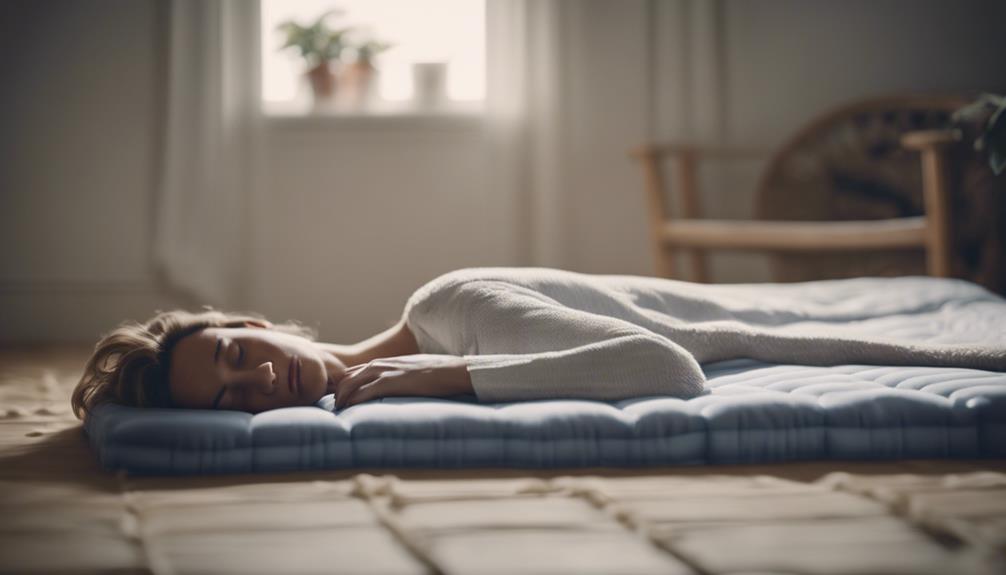
When considering sleeping on just a mattress topper, factors like thickness, material, and personal preferences are important for comfort and support. The thickness (ranging from 2 to 4 inches) impacts support, while materials like memory foam and latex affect comfort. Placing the topper on a firm, flat surface maximizes benefits. Weight and sleeping position also influence the decision. Floor sleeping considerations include maintenance, comfort, insulation, and hygiene. While toppers enhance comfort, they may lack the longevity and support of a traditional mattress. Prioritize physical and health needs for best sleep. Additional details provide insight into the pros and cons.
Key Takeaways
- Thickness and material influence standalone use.
- Consider floor type and maintenance for floor sleeping.
- Mattress toppers enhance comfort and support.
- Longevity may be shorter than a traditional mattress.
- Consult a healthcare provider for health considerations.
Factors Influencing Standalone Use
When considering the standalone suitability of a mattress topper, the thickness and material play key roles in determining its effectiveness for individual comfort needs. The thickness of a mattress topper, ranging from 2 to 4 inches, can greatly impact its ability to provide adequate support when used alone. This is especially important for individuals who prefer a softer sleeping surface. The material of the topper, whether it be memory foam or latex, also contributes to the level of comfort and support it offers. Placing the topper on a firm and flat surface is ideal for maximizing its benefits.
Factors such as weight and sleeping position should be taken into account when deciding whether to use a mattress topper alone. The Puffy Mattress Topper, known for its luxurious comfort and support, may vary in standalone suitability based on individual preferences. Hence, it's essential to take these factors into account to ensure maximum comfort when sleeping on a mattress topper alone.
Considerations for Floor Sleeping
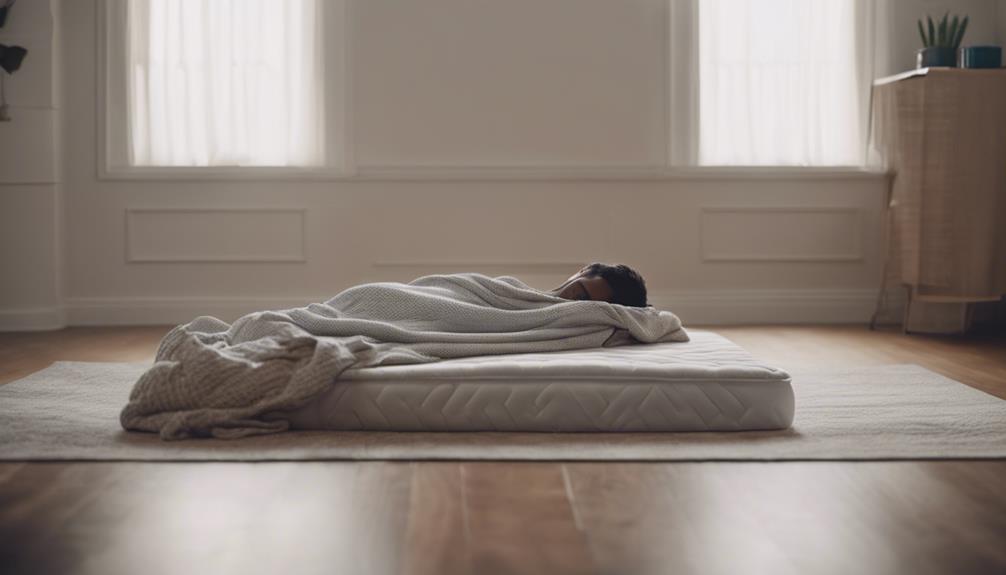
When considering floor sleeping with a mattress topper, it's important to think about the type of floor and its impact on comfort. Proper maintenance practices are vital for hygiene when using a mattress topper directly on the floor.
The benefits of floor sleeping and the suitability of different mattress toppers should also be taken into account for a comfortable night's rest.
Floor Sleeping Benefits
Considering the benefits of floor sleeping with a mattress topper, hygiene and maintenance play a crucial role in guaranteeing a comfortable and clean sleep surface. When sleeping on a mattress topper on the floor, factors like the type of floor can impact overall comfort. The mattress topper provides added cushioning and support, enhancing the sleeping experience. To give you a clearer picture, here is a table showcasing the benefits of floor sleeping with a mattress topper:
| Benefits | Description |
|---|---|
| Added Comfort | Enhances overall comfort levels |
| Improved Insulation | Helps regulate body temperature |
| Hygiene Maintenance | Maintains a clean sleep surface |
| Enhanced Cushioning | Adds extra softness for a cozy sleep environment |
| Better Support | Provides additional support for back and body |
Mattress Topper Suitability
Exploring the compatibility of mattress toppers for floor sleeping offers insights into optimizing comfort and support levels for a restful night's sleep. When considering using a mattress topper directly on the floor, factors such as comfort, insulation, hygiene, and maintenance become important.
Puffy mattress toppers are particularly well-suited for floor sleeping, as they provide added cushioning and support. It's vital to choose a mattress topper that aligns with personal preferences and the type of floor surface to enhance the overall sleeping experience. Reading comparisons and reviews can help in making informed decisions about which mattress topper would best suit floor sleeping needs.
Prioritizing comfort and proper insulation while maintaining hygiene standards are key considerations when deciding to sleep on a mattress topper on the floor.
Benefits of Sleeping on a Mattress Topper

Sleeping on a mattress topper can enhance comfort and improve support for a more restful night's sleep.
The added cushioning and pressure relief can help alleviate aches and pains, promoting superior quality rest.
With customizable firmness levels, mattress toppers can cater to individual preferences for an ideal sleeping experience.
Enhanced Comfort
Enhancing your sleep experience can be easily achieved by incorporating a quality mattress topper for added comfort and support. Memory foam mattress toppers are renowned for their ability to enhance the comfort level of your bed, offering a plush surface that molds to your body shape.
If you have a firm mattress that doesn't quite meet your preferences, a mattress topper can provide the softness you desire. Additionally, mattress toppers can help regulate your sleeping temperature, making your bed feel just right. They also offer benefits like relieving joint pain and providing essential spinal support.
Natural Latex mattress toppers are a popular choice for those seeking a more eco-friendly and durable option to enhance their sleep quality.
Improved Support
Adding a mattress topper to your bed can greatly enhance the support and comfort you experience while you sleep. This extra layer of cushioning provides improved support, particularly at pressure points like shoulders, hips, and back, offering relief and reducing aches and pains.
Memory foam toppers conform to your body shape, aiding spinal alignment and enhancing comfort. Latex toppers, on the other hand, offer a responsive surface that evenly distributes body weight, promoting better support throughout the night.
Considerations and Drawbacks
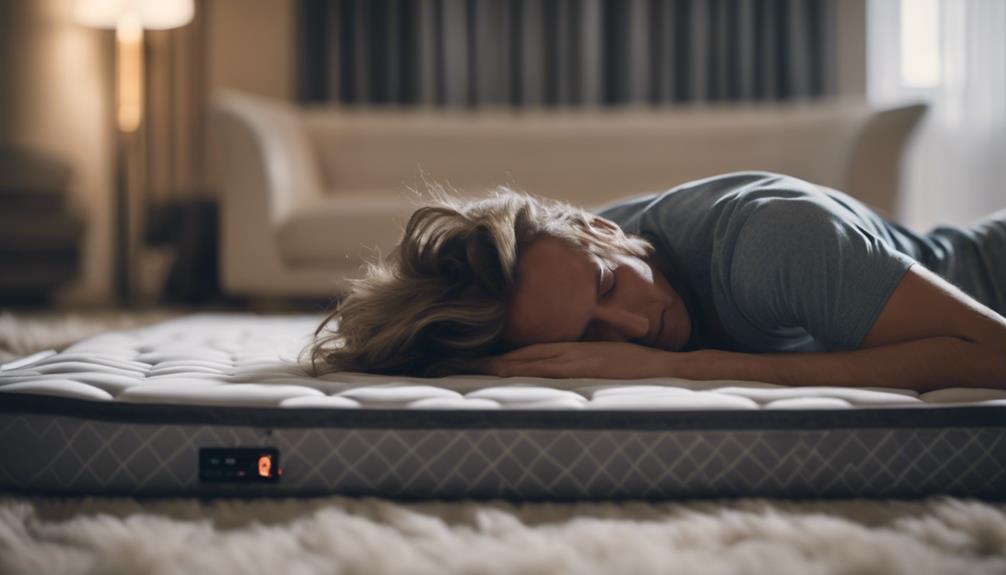
When using a mattress topper, it's important to be aware of potential drawbacks and considerations. Here are some factors to keep in mind:
- Longevity: The longevity of a mattress topper may not match that of a traditional mattress, as it might wear out quicker due to direct contact with your body.
- Spinal Support: Using a mattress topper alone on a bed may not offer the same level of spinal support as a full mattress, which could lead to discomfort or back pain.
- Hygiene Maintenance: Regular cleaning and maintenance are vital to prevent the buildup of dust mites and allergens in the mattress topper, ensuring a healthy sleeping environment.
- Comfort Levels: While a mattress topper can enhance comfort, the overall feel and support may still differ from what a traditional mattress provides, impacting your sleep quality.
Being mindful of these considerations can help you make an informed decision about using a mattress topper for your bed.
Advantages of Using a Mattress Topper as a Mattress
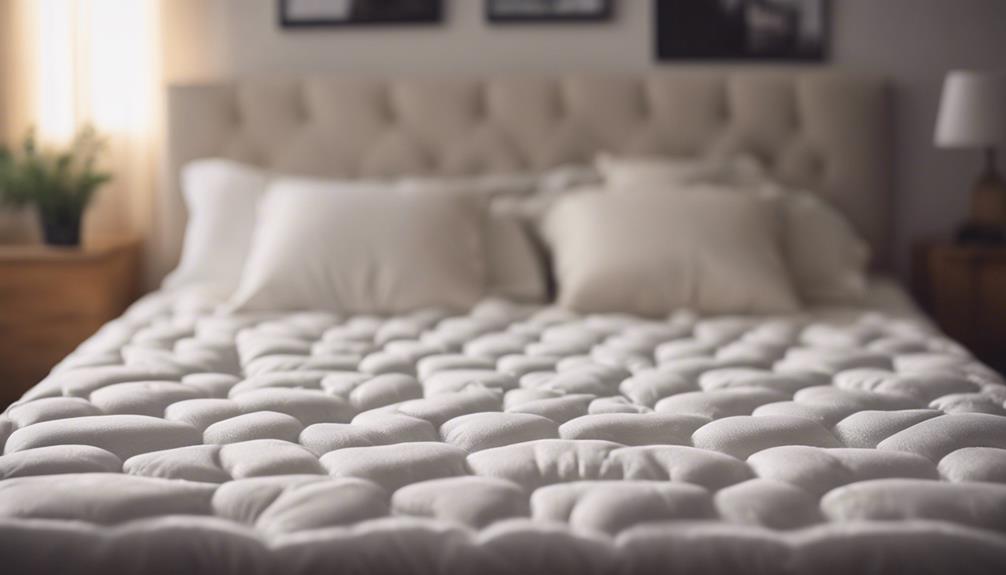
Opting for a mattress topper as a standalone bed solution offers a practical and economical alternative to purchasing a new mattress. Whether you're looking to improve the comfort of an old mattress or need a temporary sleeping arrangement, using a mattress topper can be an attractive option. Memory foam toppers, for example, provide body contouring that can help alleviate chronic pain and mobility issues, offering a more supportive sleep surface.
Here is a table summarizing some of the advantages of using a mattress topper as a mattress:
| Advantages | Description |
|---|---|
| Extended Use | Transform an old mattress and extend its usability |
| Sustainable | Reduces mattress waste in landfills, promoting environmental sustainability |
| Cost-Effective | Economical alternative to purchasing a new mattress |
Disadvantages of Using a Mattress Topper as a Mattress

While mattress toppers offer benefits like improved comfort, there are notable disadvantages to take into account when using them as standalone mattresses. Here are some drawbacks to bear in mind when opting to sleep on a mattress topper rather than a traditional mattress:
- Lack of Proper Support: Thin mattress toppers may not adequately support your body, especially in the long term, leading to discomfort and potential issues with your lower back.
- Hygiene Challenges: Cleaning foam mattress toppers can be tricky due to their size and material, which can result in the accumulation of dust mites over time, impacting hygiene.
- Short-Term Solution: Using a topper as a mattress is usually a short-term fix, as it may not provide the durability and support needed for nightly use.
- Placement Concerns: Placing a mattress topper directly on the floor can further compromise support and comfort, affecting the quality of your sleep.
Considering these disadvantages, it's vital to weigh the pros and cons before deciding to solely rely on a mattress topper for your sleep needs.
Physical and Health Needs to Consider
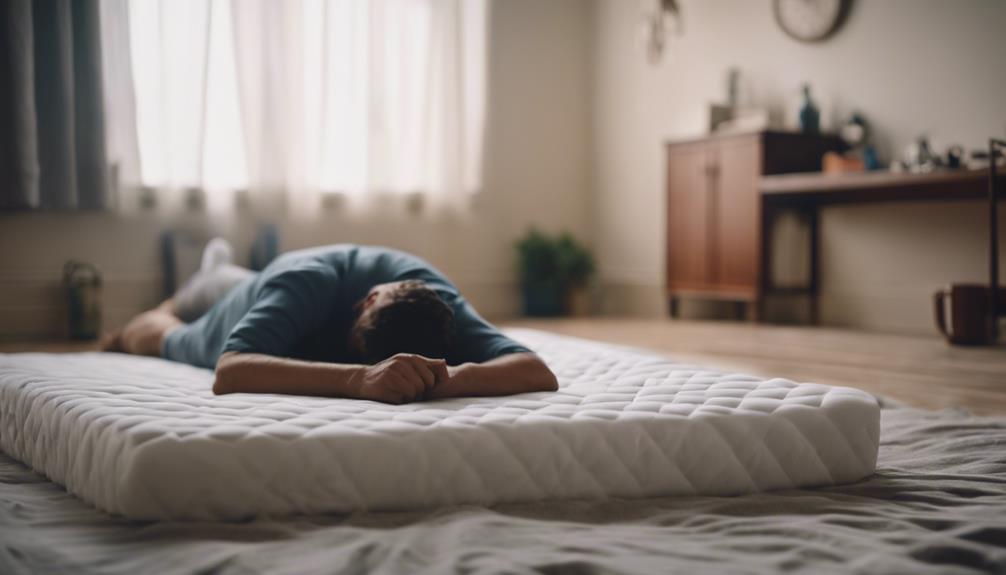
Taking into account physical and health needs is vital when selecting a suitable sleep surface for maximum comfort and well-being. Sleeping directly on a mattress topper on the floor may worsen allergies due to dust mites and mold accumulation. Individuals with chronic pain or mobility issues often require specific mattress support to alleviate discomfort and promote better sleep quality. Additionally, temperature regulation can be challenging when using a topper directly on the floor, impacting sleep comfort. Health conditions such as anemia or hypothyroidism can also affect sensitivity to cold temperatures, making it important to think about insulation when sleeping on a topper.
Consulting a healthcare provider is highly recommended before opting to use a mattress topper as the primary sleep surface. This professional assessment can help determine if the topper provides adequate support for specific health needs and ensures that potential issues like chronic pain or mobility issues are addressed effectively. By prioritizing physical and health requirements, individuals can optimize their sleep environment and overall well-being.
Frequently Asked Questions
Can You Use a Mattress Topper on Its Own?
Yes, you can use a mattress topper on its own for short-term sleeping. It's designed to enhance comfort but may lack long-term spinal support. Toppers are typically 2 to 4 inches thick, made of materials like memory foam or latex.
Using a topper as a standalone bed could impact its longevity and warranty. While suitable temporarily, it may not offer the same support as a traditional mattress.
Can You Use a Mattress Topper Instead of a Mattress?
Yes, a mattress topper can be used instead of a mattress, but its suitability may vary depending on factors like weight and preferred sleeping position.
Memory foam or latex toppers, like Puffy Mattress Toppers, offer comfort and support.
Consider the topper's thickness, material quality, and surface firmness when deciding to use it as a standalone bed.
Your sleep preferences and needs should guide your choice for best comfort and rest.
Can You Sleep on a Mattress Topper Without a Sheet?
Without a sheet, sleeping directly on a mattress topper can expose it to sweat, oils, and dirt, impacting hygiene and comfort.
Sheets act as a protective barrier, preventing direct contact with the topper and can be easily washed to maintain cleanliness.
Opting to sleep without a sheet may compromise sleep quality and the lifespan of the topper.
It's advisable to use a sheet for both hygiene and comfort reasons.
Can I Use a Mattress Topper as a Floor Mattress?
Yes, using a mattress topper directly on the floor can provide added comfort for sleeping. It offers insulation and a cushioning layer, enhancing the sleeping experience.
However, importance and maintenance are vital considerations. Different floor types can impact the overall comfort level, so choosing a suitable spot is important. Regular cleaning and care will help maintain the topper's quality.
Conclusion
To sum up, sleeping on just a mattress topper may not provide the support and comfort needed for a restful night's sleep. While it can be a temporary solution or used for floor sleeping, it may not be ideal for long-term use.
Consider investing in a proper mattress for better sleep quality and overall well-being. Remember, a good night's sleep is like a gentle breeze on a warm summer night, soothing and rejuvenating for the soul.
Xavier – Your Operations Partner Xavier is your operations partner, working tirelessly behind the scenes to ensure that everything runs smoothly so you can enjoy a seamless experience with Perfect Fit Living. From managing inventory to coordinating logistics, he’s committed to making your experience with us hassle-free.
-

 Decorative Throws2 weeks ago
Decorative Throws2 weeks agoIs It Better to Dry Clean Blankets?
-

 Yarn2 weeks ago
Yarn2 weeks agoIs Yarn Natural or Manmade? Unravel the Truth
-

 Decorative Throws2 weeks ago
Decorative Throws2 weeks agoWhat Wattage Is an Electric Throw
-

 Decorative Throws2 weeks ago
Decorative Throws2 weeks agoCan I Use a Throw Blanket as a Rug
-

 Yarn2 weeks ago
Yarn2 weeks agoUnravel the Mystery: Why Are Yarn Specs a Secret?
-

 Tableware and Dining Accessories2 weeks ago
Tableware and Dining Accessories2 weeks agoWhat Is the Meaning of the Word Tableware
-

 Craft and Textiles2 weeks ago
Craft and Textiles2 weeks ago15 Best Battery-Powered Leaf Blowers for Effortless Yard Work
-

 Craft and Textiles2 weeks ago
Craft and Textiles2 weeks ago15 Best Toast Recipes to Start Your Day Right













